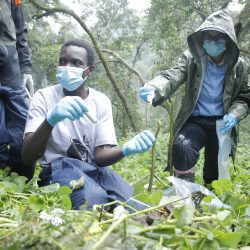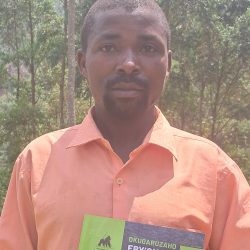Just Born and Just Counted: Census of mountain gorillas in Bwindi continues
Blog | 23/09/11
Through the vegetation, meet the newest member of the Kyaguliro family group in Bwindi Impenetrable National Park in Uganda. Born to Tindamanyire on Thursday, September 15th, it was born just in time to be counted in the census of mountain gorillas that is currently underway.

Another glimpse of the infant while Tindamanyire rests and eats on her back while the baby rests on her chest.
This little infant was born just in time because on Friday, September 16th, a census team following a systematic reconnaissance or ‘recce’ trail, encountered the trail of the Kyaguliro group, meaning that it was at that point in time that the Kyaguliro family group was counted. For a habituated group of gorillas, like Kyaguliro, the known number of individuals in the group will be included in the final count. Kyaguliro is habituated for the purpose of research, the only research group in Bwindi and is monitored on a daily basis by the Uganda Wildlife Authority and Dr. Martha Robbins of the Max Planck Institute and a team of field assistants and students.
Earlier this week, Dr. Allan Carlson with WWF-Sweden, part of the coalition of the International Gorilla Conservation Programme, and I were offered a behind-the-scenes look at the amazing mountain gorillas of Bwindi Impenetrable National Park as well as the amazing people in the field as I write that are collecting the data and samples for the census. For this blog, I will focus on the raison d’être for the census- the mountain gorillas themselves.
Bwindi may not have the volcanoes of the Virunga Massif, but it is no less impressive. Bwindi’s defining feature is the dense forest the folds over the steep hills and valleys. It makes it simultaneously breathtakingly beautiful and very difficult to maneuver in, if you are an average person that is. But the efforts are well rewarded as a turn in the trail could bring you to a lush stand of tree ferns or tall forest stands with a high canopy, black-and-white colobus monkeys, hornbills, or even a brightly colored snake.
On Monday, those are just a few of the things we found. After a quick stop at the base camp near Mbwindi swamp for some tea and a chat, we hiked to where the Kyaguliro group was known to be feeding.
Immediately we got a look at Tindamanyire and her new baby followed by a glimpse of the group’s silverback, named Rukina. Although Rukina sat down and started eating, he was regularly communicating to us new visitors as well as his family group. As Rukina was grunting to assure his group that all was fine, all of us humans were instinctively responding as well with our own back-of-the-throat calls to also confirm to him that all was truly ok.
We stopped to watch a young male systematically strip and eat the vegetation around him. See the video of this eating behavior via YouTube here. We also stopped to chat very quietly about this group and its history.

Rip, strip, eat, repeat. A member of the Kyguliro family group carries on with his meal as we observe.

Dr. Allan Carlson with WWF-Sweden, part of the IGCP coalition, photographs gorillas while Dr. Martha Robbins observes.
Toward the end of our time with the Kyaguliro group, we found ourselves on a steep slope with vines. Although the other members of our group gracefully maneuvered their way back more level ground, I missed a step and found myself tumbling backwards and much to my dismay, I was not only tumbling but rolling in backward somersaults not once, not twice, but a spectacular three times. With all parts of my body and equipment intact, I clamored back up the slope and joined Martha.
A few moments later we saw Rukina nearby and he sat and looked at us. We also stopped moving and sat down ourselves. Maybe he didn’t have a good view of things, or maybe it was for a different reason, but he came closer and intensely looked at both Martha and I. It was a very intense experience as you can imagine, but he was likely just curious and possibly curious about the commotion he had heard and was there to check out the situation.
We sat for quite a while as Rukina communicated back and forth with other members of the group, Martha telling me that he was likely indicated to them that it might be time to transition from one area to another. He eventually did move up and away from us, allowing me to finally exhale completely and revel in what an amazing species mountain gorillas are.
Although the Kyaguliro group is habituated and intensely monitored on a daily basis, the census will give researchers and us important insights into this particular group. For example, Martha is very keen to see if the silverback named Ntegenisa is found. In 1999, Ntegenisa emigrated out of the Kyaguliro group, but not before he had been genotyped from genetic material extracted from fecal matter.
Although the entire population was not genetically tested (again from fecal matter) during the census conducted in 2002, he was identified as a solitary male. And in 2006, when the entire population was genetically tested he was identified as the silverback in a group of nine individuals. So, although he has not been physically seen since 1999, Martha knows that he is out there leading an unhabituated family group in the hills of Bwindi. I can’t wait to find out if Ntegenisa is discovered again in this current census as well.
As I alluded to before, the people involved in this census are equally amazing and deserving of individual recognition as the mountain gorillas of Bwindi and the individuals of the Kyaguliro family group. But these stories, I will save for another day.
Special thanks to Dr. Martha Robbins, her field assistants, and the Uganda Wildlife Authority for facilitating and authorizing us for this special visit to the Kyaguliro group.









